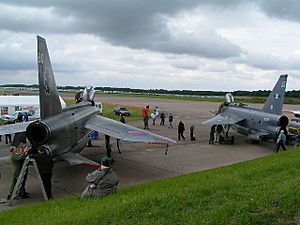Bruntingthorpe Aerodrome facts for kids
Quick facts for kids
Bruntingthorpe Aerodrome
|
|||||||||||||||
|---|---|---|---|---|---|---|---|---|---|---|---|---|---|---|---|
 |
|||||||||||||||
| Summary | |||||||||||||||
| Airport type | Former private | ||||||||||||||
| Operator | Cox Automotive | ||||||||||||||
| Location | Bruntingthorpe, Leicestershire | ||||||||||||||
| Elevation AMSL | 467 ft / 142 m | ||||||||||||||
| Coordinates | 52°29′13″N 001°07′50″W / 52.48694°N 1.13056°W | ||||||||||||||
| Website | https://www.coxauto.co.uk | ||||||||||||||
| Map | |||||||||||||||
| Runway | |||||||||||||||
|
|||||||||||||||
Bruntingthorpe Aerodrome and Proving Ground is a special place in Leicestershire, England. It's a privately owned site that used to be an airport. It's located about 11 miles south of Leicester, near the village of Bruntingthorpe. This site first opened in 1942 as RAF Bruntingthorpe, a base for the Royal Air Force.
Contents
The Story of Bruntingthorpe Airfield
Bruntingthorpe Aerodrome has a long and interesting past. It began as RAF Bruntingthorpe during World War II. Both the Royal Air Force (RAF) and the United States Air Force used it.
In 1973, the site was sold to Chrysler Motor Corporation. They used it as a place to test vehicles. Later, in August 1983, C Walton Ltd bought the aerodrome. It continued to be a vehicle testing ground.
The site also became home to historic aircraft. It hosted air shows and provided space for events. In 2020, Cox Automotive bought the main part of the site. They use it for storing and auctioning vehicles. The Walton family still keeps a part of the site for aircraft activities.
What Happens at Bruntingthorpe Today?
Bruntingthorpe is a busy place with different uses. It's known for both vehicles and aircraft.
Vehicle Activities at Bruntingthorpe
The site is very large and can hold about 25,000 vehicles. These cars are often parked on the old runways and taxi areas.
One of the large hangars used to be a car auction center. Today, Royal Enfield Motorcycles has its Worldwide Technology Centre here. They design and develop new motorcycles at Bruntingthorpe.
Aircraft at Bruntingthorpe
Bruntingthorpe has been home to many famous aircraft. One of the most well-known was the Avro Vulcan XH558. This amazing aircraft was restored to flying condition. It took eight years and cost about £6,000,000.
The Vulcan's first flight after restoration was from Bruntingthorpe on October 18, 2007. It later moved to other bases for its flying displays. The Vulcan is now grounded and located at Doncaster Sheffield Airport.
The Cold War Jets Collection aircraft museum is also at Bruntingthorpe. It displays many historic aircraft. Some aircraft from the collection have moved to other museums, like the South Wales Aviation Museum.
Several large aircraft have visited Bruntingthorpe. The Vickers VC10 C1K XR808, nicknamed "Bob," arrived in 2013. It has since moved to the RAF Cosford museum. Six Lockheed TriStar aircraft were stored here in 2013. They were later taken apart for parts. The very last VC-10 to fly, ZA147, was also stored here before being scrapped.
Aircraft Safety Test in 1997
In 1997, Bruntingthorpe Airfield was used for an important safety test. The Federal Aviation Administration (FAA) from the US and the Civil Aviation Authority (CAA) from the UK worked together. They wanted to study how large aircraft react to explosions. This research helps make air travel safer for everyone.
They used an old Boeing 747-100 aircraft for the test. Four special devices were set off at the same time. These were placed in the luggage areas under the floor. Three of the four areas were protected with strong materials like Kevlar. One area was left unprotected to see what would happen.
Many cameras recorded the test from inside and outside the plane. A famous photo shows the back left side of the aircraft being blown outwards. The protective measures worked well, containing the other three explosions.
Later, photos from this test were used in a fake story. The hoax claimed an Air Canada Boeing 747 had exploded while landing. However, it was just an edited picture. Someone had combined a normal landing photo with the explosion test image.
Unplanned Flight Incident
On May 3, 2009, an interesting event happened during a "fast taxi" run. A Handley Page Victor aircraft, XM715, was moving quickly on the runway. It unexpectedly lifted into the air, reaching about 20 to 30 feet high. The aircraft then landed safely.
This aircraft did not have permission to fly. The Civil Aviation Authority (CAA) looked into the incident. They found that a mistake in communication led to the brief lift-off. No legal action was taken against the crew or the airfield operators.
See also
- Strategic Air Command in the United Kingdom
- United States Air Forces in Europe


